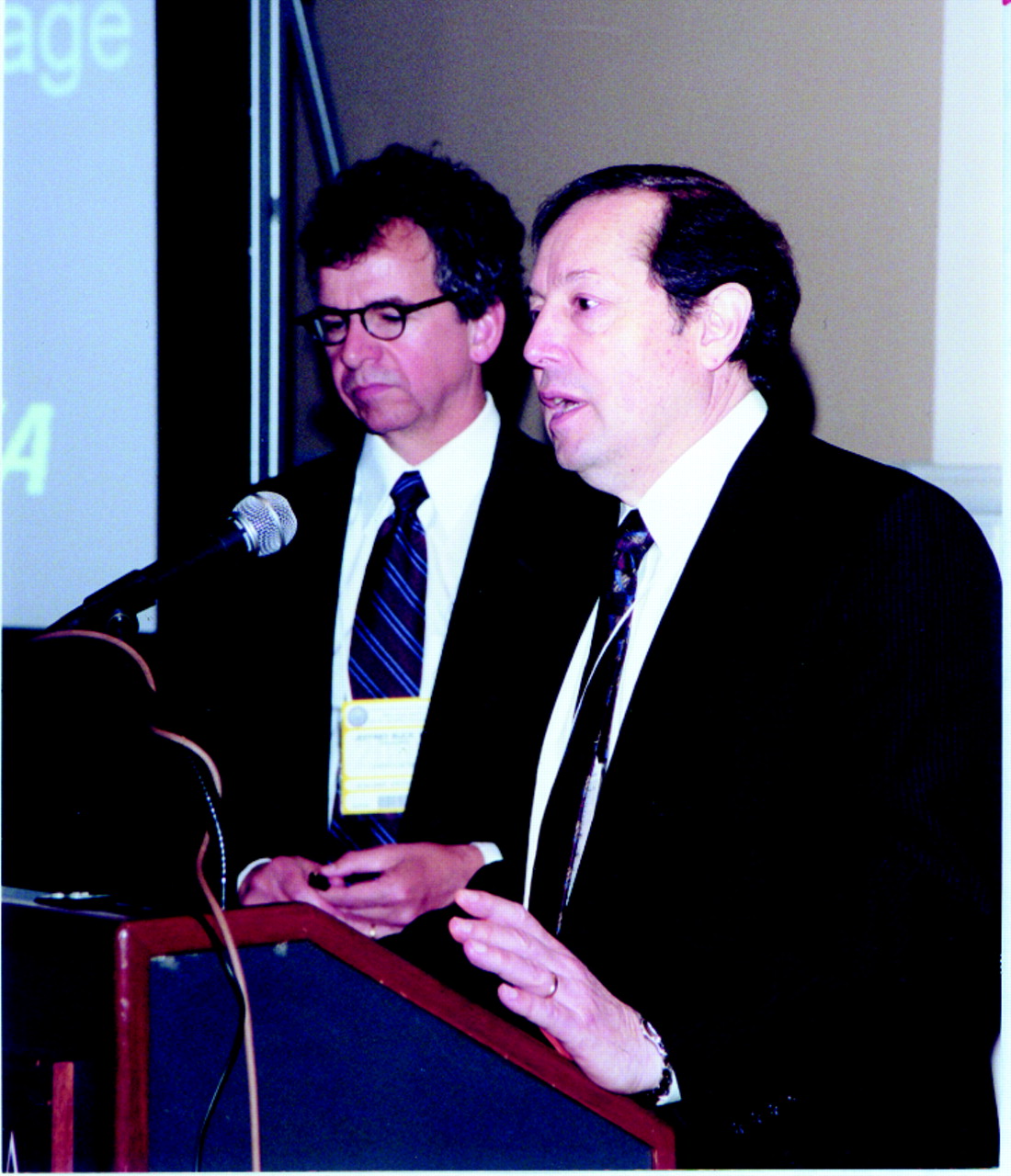More Data Confirm Affordability of Parity

Darrel Regier, M.D. (right), tells meeting attendees that estimates of the costs of parity are decreasing, but the impact on access is still an open question. At left is Jeffrey A. Buck.
His words proved prophetic when a week later, Jay Cutler, J.D., director of APA’s Division of Government Relations, announced that a majority of the members of the House of Representatives are cosponsoring the Mental Health Equitable Treatment Act (HR 4066). Two-thirds of the members of the Senate are cosponsors to the companion bill (S 543).
The burgeoning congressional support follows President Bush’s recent endorsement of parity (Psychiatric News, May 17).
At the workshop Jeffrey A. Buck, associate director for organization and financing at the federal Center for Mental Health Services, offered an overview of parity legislation and its impact on insurance costs and use of mental health services.
Provisions of Current, Proposed Legislation
The Mental Health Parity Act of 1996 applies only to group health plans that offer mental health benefits, exempts small employers, and offers an exemption from its provisions if costs to employers increase by 1 percent or more a year. Parity is limited to annual and aggregate lifetime maximums and does not address visit limits or cost sharing.
Although it was scheduled to sunset in 2001, Congress extended the legislation to 2002.
More than 30 states have passed parity laws with more expansive provisions than those in the Mental Health Parity Act of 1996. However, these laws often exclude treatment for substance abuse and/or diagnoses that are not defined in the laws as “serious” or “biologically based” mental illnesses. Also, they do not apply to plans that are self-funded and often exempt small businesses.
On January 1, 2001, federal employees and their dependents received parity coverage for mental health and substance abuse care through the Federal Employee Health Benefits Program (FEHBP). Limits and cost sharing (such as deductibles, coinsurance, and copays) are the same for mental health and substance abuse care as for other kinds of medical care.
The proposed Mental Health Equitable Treatment Act (S 543, HR 4066) would provide full parity for all categories of mental illness listed in DSM, except for substance abuse disorders. It would exempt employers with fewer than 50 employees and does not require an employer to offer mental health coverage.
Buck noted that about 40 percent of employees in the United States are working in firms with fewer than 50 employees.
Parity Costs Low
Some early estimates of the effects of parity on costs of insurance were as high as 10 percent. In 2000 the General Accounting Office (GAO) reported that most studies estimated cost increases in premiums for full parity to be between 2 percent and 4 percent.
Also in that year, the National Advisory Mental Health Council (NAMHC) estimated the increase at 1.4 percent for full mental health and substance abuse coverage. After six months’ experience with full parity benefits for federal employees, the Office of Personnel Management reported in July 2001 an increase in total benefit costs of 1.3 percent.
Buck said that case studies of five states with parity laws showed that most insurers reported increases in premiums of a “few percent or less.”
In fact, a study of the impact when parity for severe mental health and substance abuse disorders became available for state employees in Texas found a decrease of 50 percent in per-member per-month costs. Managed care was introduced at the same time.
Similar results occurred in North Carolina when managed care and mental health parity for state employees were introduced simultaneously in 1991. (See Original article: page 20 for a recent study of a large employer that also simultaneously introduced managed care and parity.)
A study of the impact of California’s parity for the first year of implementation also found no evidence of increase in costs (Psychiatric News, June 7).
In 2001 the Congressional Budget Office (CBO) estimated the annual increased cost for S 543 to be .9 percent. In a memo dated May 22, the CBO stated that the estimate was based on the assumption that the bill would require affected group health plans to cover all mental illnesses listed in the most recent edition of the Diagnostic and Statistical Manual of Mental Disorders (DSM), with the exception of substance abuse disorders.
Almost all of the cost increase associated with mental health parity results from increases in payments for people suffering from severe mental illness, according to the CBO.
Regier told Psychiatric News, “After years of watching HMOs and insurance companies attempt to avoid covering serious mental illness, we are delighted that long-standing battle appears to be over, and the argument is now focused on coverage for less severe mental illness.”
He added, “As the CBO pointed out and insurance companies have long known, it is easier to control costs of less severe mental illness. The recent CBO analysis laid to rest the specious argument that covering all the DSM [diagnoses] would open the floodgates in terms of cost.”
What’s Next?
Regier told attendees that the first stage of APIRE’s study of the impact of the FEHBP’s parity benefit in the National Capital Area is complete and establishes a data baseline. The National Capital Area has more than 1 million federal employees and dependents.
The follow-up survey will capture information about changes in management and access to treatment for FEHBP enrollees and about the movement of psychiatrists in and out of networks through which parity benefits operate.
The study is particularly timely, according to Regier, because the parity provisions of the FEHBP are very similar to those of S 543.
“There is a great deal of anecdotal evidence that access to psychiatrists is decreasing because of managed care, even though mental health benefits are expanding through parity provisions,” said Regier. “We have a responsibility to find out what the facts are for the sake of our patients and our colleagues.” ▪



